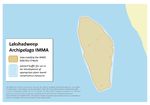Lakshadweep Archipelago IMMA - Summary (continued) - Marine Mammal Protected Areas ...
←
→
Page content transcription
If your browser does not render page correctly, please read the page content below
Lakshadweep
Archipelago IMMA
Summary (continued)
atolls. However, further research is required to
determine their population status. Additional
research is also recommended on the possible
connections between the species complexes and
populations in the Maldives, which are also part of the
larger Chagos-Laccadives plateau.
Area Size
86,717 km2
Description
The highly variable bathymetry and diverse
Qualifying Species and Criteria oceanographic habitats within the Lakshadweep
Archipelago IMMA create the perfect environment for
Marine Mammal Diversity (D2)
a vast diversity of marine life. The proximity of the
Tursiops aduncus, Stenella longirostris, Tursiops Lakshadweeps to the Maldives suggests an overlap
truncatus, Globicephala macrorhynchus, in biodiversity of marine megafauna and possible
Grampus griseus, Stenella attenuata, Stenella genetic relationships between cetacean populations.
coeruleoalba, Pseudorca crassidens, Feresa In a recent study, the most commonly sighted
attenuata, Kogia sima, Physeter macrocephalus, species was the spinner dolphin, Stenella longirostris
Ziphius cavirostris, Orcinus orca, Balaenoptera (22 sightings; group size ranged from 1 to 600 with
musculus mean group size of 96.1±35.7) followed by bottlenose
dolphins, Tursiops spp. (18 sightings; group size
ranged from 1 to 10 with mean group size of
Summary
4.52±0.67) and short finned pilot whales, Globicephala
The Lakshadweep Archipelago is a complex of macrorhynchus (13 sightings; Group size ranged from
coral atolls located 220-440 km to the southwest 2 to 40 with mean group size of 17.46±3.6) (Panicker et
of the Indian mainland. The area consists of al., 2020).
diverse habitat types: coral reefs, seagrass beds,
rocky and sandy shores, mangrove creeks, deep- Criterion D: Special Attributes
water canyons and trenches that offer a vast Sub-criterion D2: Diversity
biodiverse marine landscape for
cetaceans. Deep-water slopes like the ones The complex bathymetry of the Lakshadweep
found around Lakshadweep generate currents Archipelago supports at least 14 cetacean species.
and upwelling of nutrients that aggregate The shallow waters around the islands are used by
plankton and attract a diversity of marine spinner dolphins and bottlenose dolphins throughout
life. Based on confirmed sightings, carcasses the year. In dedicated research surveys including
washed ashore and anecdotal information at almost 3900 km of survey distance, over 129 hours,
least 14 species of cetaceans have been were undertaken, resulting in 139 cetacean sightings
documented throughout the area. The two most (Panicker et al., in 2020). Cetacean species with
commonly observed species are Indo-Pacific confirmed sightings within the IMMA are Risso’s
bottlenose dolphins (Tursiops aduncus) and dolphins, bottlenose dolphins (species not
spinner dolphins (Stenella longirostris), which are determined), striped dolphins, spinner dolphins,
present year-round inside and at the edge of the Cuvier’s beaked whales, dwarf sperm whales, short-
finned pilot whales, sperm whales, false killer whales,pantropical spotted dolphins, pygmy killer whales,
killer whales, sperm whales, as well as other
unidentified baleen whales (Panicker, 2017).
Nearshore areas include rich seagrass beds used by
green sea turtles, olive ridley turtles and several
species of elasmobranchs. Fisher reports suggest
seasonal occurrence of large whales identified by
blows that can be seen from a distance. Given the
limited survey effort, the cetacean diversity from this
region may be underestimated, with deep-diving,
cryptic or rare species under-represented. See
Figure 1 for sightings information.
Supporting Information
Afsal, V. V., K. S. S. M. Yousuf, B. Anoop, A. K. Anoop, P.
Kannan, M. Rajagopalan, and E. Vivekanandan. 2008.
A note on cetacean distribution in the Indian EEZ and
contiguous seas during 2003-07. Journal of Cetacean
Research and Management 10(3): 209-216.
Kumar, KV Aneesh, Sibi T. Baby, K. V. Dhaneesh,
Hashim Manjebrayakath, N. Saravanane, and M.
Sudhakar. 2018. A Stranding Record of Dwarf Sperm
Whale Kogia sima in Lakshadweep Archipelago, India
and its Genetic Analogy by Molecular Phylogeny.
Thalassa: An International Journal of Marine Sciences
1-7.
Panicker, D, Sutaria, D, Kumar, A, Stafford, K. (2020).
Cetacean Distribution and Diversity in Lakshadweep
Waters, India Using a Platform of Opportunity:
October 2015 to April 2016. Aquatic Mammals. 46 (1):
80-92
Panicker, D. 2017. Cetacean Diversity and Distribution
in the Lakshadweep Islands, India. Final report to
Rufford Foundation for Small Grants
https://www.rufford.org/files/16159-2 Final
Report.pdf
Sajikumar, Kurichithara, K., Nadakkal Ragesh, and
Kolliyil S. Mohamed. 2014. Behaviour of Short-finned
Pilot Whales Globicephala macrorhynchus (Gray,
1846) (Mammalia: Cetartiodactyla: Delphinidae) in the
southeastern Arabian Sea. Journal of Threatened
Taxa. 6(11): 6488-6492.
Figure 1: Cetacean sightings in the Lakshadweep waters
categorized by species and class. From Panicker et al., 2020.Acknowledgements We would like to thank the participants of the 2019 IMMA Regional Expert Workshop held in Salalah, Oman for the identification of IMMAs in the Western Indian Ocean and Arabian Seas. Funding for the identification of this IMMA was provided to the Global Ocean Biodiversity Initiative by the International Climate Initiative (IKI). The German Federal Ministry for the Environment, Nature Conservation and Nuclear Safety (BMU) supports this initiative on the basis of a decision adopted by the German Bundestag. Support was also provided by Whale and Dolphin Conservation and the Tethys Research Institute. Suggested Citation: IUCN-Marine Mammal Protected Areas Task Force, 2021. Lakshadweep Archipelago IMMA Factsheet. https://www.marinemammalhabitat.org/wp- content/uploads/imma-factsheets/ WesternIndianOcean/lakshadweep-archipelago- WesternIndianOcean.pdf. Downloaded on (day month year). PDF made available for download at https://www.marinemammalhabitat.org/wp- content/uploads/imma-factsheets/ WesternIndianOcean/Lakshadweep-archipelago- WesternIndianOcean.pdf.
You can also read





















































